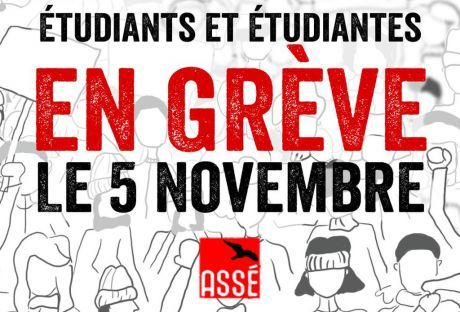News
You are here
Quebec students join public sector workers on strike and in the streets

November 7, 2015
On November 5, ASSÉ, the main student union behind Quebec’s “Maple Spring,”held a Quebec-wide student walkout and rally in Montreal in solidarity with Quebec’s “Common Front” of public sector unions.
While the Common Front—which represents almost all the major trade union federations in Quebec, including about 400,000 provincial government workers and broader public sector workers like teachers in CEGEPs and schools—is taking legal strike action as part of negotiations with the Quebec government, it is also staging these job actions as a general campaign against austerity.
It is this fall campaign by unions that was at the centre of a strategic debate last spring amongst Quebec students about how to reignite the “Maple Spring,” which in 2012 included widespread grassroots support in neighborhoods and communities.
A new “Maple Spring” in 2015?
Some students wanted to initiate a struggle against austerity through a renewal of their own strike activity by taking strike votes in the spring, while others wanted to wait for the fall when the unions might take up the torch—and take the fight against austerity to a new level.
Both strategies had risks. Some students did vote to strike and walked out last spring, and there were large popular protests to support them—more than enough to show that the movement was dormant but not dead. However, there had been a generational turnover in the student movement, a fragmentation of the former broad leadership, and less time to build the movement from the ground-up.
But most importantly, there wasn’t a specific focus in the spring of 2015 as there had been in 2012, when the fight targeted a specific tuition hike and a specific law against dissent: the campaign of 2015 was waged as a general fight against all the impacts of austerity. This did put thousands of students and supporters in the streets, and even inspired strike votes and some illegal job action by CEGEP teachers—against austerity itself.
But with no specific target or goal to come out of the struggle, motivating hundreds of thousands of students to take strike action, and to stay out indefinitely with potential risk to their term, as they had before, was just not possible.
The argument to wait for the fall, however, meant banking on an unknown: would the unions deliver on the fight they seemed to promise? Would they fight at all, and if so, would the campaign be confined to narrow bargaining demands rather than the social struggle triggered by the students?
Common Front
This fall, the Common Front has at least demonstrated that it is a force to be reckoned with. They mobilized 150,000 people in the streets of Montreal on October 3 in a show of force, and since then have engaged in a number of job actions. So far this has consisted of rotating strikes, a common tactic in Quebec.
They have varied in size and impact, but the October 29 strike by health, education, and Quebec human rights commission workers in the Montreal region was quite large. Although rotating strikes are not as sustained as the months-long strike by students in 2012, the Common Front has focused their message on linking this legal strike action to the more general sentiment against austerity.
ASSÉ spokesperson Hind Fazazi, in the lead-up to the November 5 protest said that students now “get” austerity in the same way they understood what the impact of the tuition hikes would be in 2012. Quebec colleges have seen $149 million in budget cuts in the last five years (about $70 million was cut from Quebec universities in 2015-16 alone. ASSÉ calls for higher taxes on large businesses and fighting tax evasion to reinvest in the public sector.
On November 5, around 50,000 students represented by close to 20 student associations staged actual walkouts from class with official strike votes in hand—against government austerity in general. Around 5,000 marched in Montreal, and CEGEP students in other parts of Quebec held local actions under the banner “Je sauve mon Cégep” (“I’m saving my CEGEP”).
What’s next?
Public sector workers have just rejected the government’s latest offer so the movement will march forward to other planned strike days. The Common Front has rotating strike days tentatively scheduled in Montreal on November 16 and 17, as well as December 1, 2 and 3. Five days of student strike are planned for November 12 and 13, and December 1, 2 and 3. This represents an important escalation of the rotating strike strategy from a single day up to three days of all-out strike.
On November 28, the Coalition against user fees and privatisation of public services will hold a national demonstration in Montreal to make the community angle visible. And the ongoing protests by parents to protect public schools by forming human chains around them at the beginning of each month will also feed into the early December escalation.
Many questions now arise: how far will the movement go? Will labour, community, and students unite in an ongoing and “official' common front? One is in the making, but the broader movement is dependent on what labour will do.
The actions so far have let all these sectors see each other and feel their solidarity. They are remembering 2012.
Ce n’est qu’un début, continuons le combat ! (This is only a beginning, continue the struggle!)
Section:










